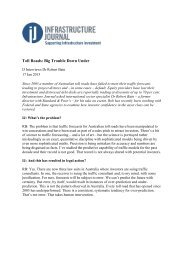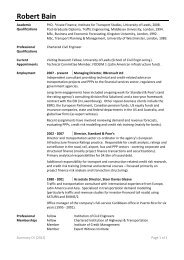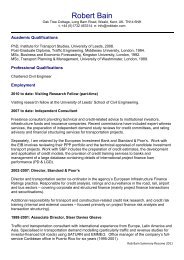Disincentivising overbidding for toll road concessions
Disincentivising overbidding for toll road concessions
Disincentivising overbidding for toll road concessions
- No tags were found...
Create successful ePaper yourself
Turn your PDF publications into a flip-book with our unique Google optimized e-Paper software.
DISINCENTIVISING OVERBIDDING FOR TOLL ROAD CONCESSIONS<br />
2.2 Potential explanations<br />
2.2.1 The winner’s curse<br />
The tender design determines the process by which bids are made in <strong>concessions</strong> contracting, and the price paid by<br />
the winner. One way to consider this is in the context of auction theory. Although procurement in the Australian <strong>toll</strong><br />
<strong>road</strong>s sector does not follow an archetypal auction <strong>for</strong>mat, contract award has been closely influenced by the size of<br />
the upfront payment offered by the bidding consortia. As such, there is potential <strong>for</strong> auction theory to provide insight<br />
into how tendering processes can be designed to ensure optimal bidding and into the reasons why an <strong>overbidding</strong><br />
problem may arise<br />
The literature has distinguished between two (pure) types of auction, according to the value assumptions on which<br />
they are founded:<br />
••<br />
private-value auctions—bidders each value the item differently and, while each is certain of their own valuation,<br />
there is uncertainty about the value of the item to other bidders;<br />
••<br />
common-value auctions—the ‘true’ value of the item is the same to all bidders, but each has a different estimate<br />
regarding the underlying value, based on the signals they receive prior to bidding. As such, a feature of commonvalue<br />
auctions is that bidders do not know the value of the item at the time of bidding. The common-value<br />
assumption has most frequently been applied to the analysis of auctions <strong>for</strong> mineral rights, but has also been<br />
used in the <strong>toll</strong> <strong>road</strong> context. 20<br />
To the extent that a <strong>toll</strong> <strong>road</strong> concession has the same value to all bidders, the procurement process can be thought<br />
of in the context of a common-value auction. In this framework, <strong>overbidding</strong> might be explained by the ‘winner’s<br />
curse’. This problem is well-developed (and has been extensively discussed) in the economics literature, and thus<br />
provides a reasonable starting point <strong>for</strong> considering the <strong>overbidding</strong> problem.<br />
The theory<br />
The winner’s curse refers to the phenomenon by which winning bidders are found to have systematically bid amounts<br />
that are greater than the ‘true’ value of the auctioned item, and thus either lose money or obtain less profit than the<br />
winning bidder anticipated. Potential winner’s curse problems have been highlighted in auctions <strong>for</strong> oil field leases in<br />
the Outer Continental Shelf, 21 book publication rights, 22 the free agency market <strong>for</strong> professional baseball players, 23<br />
and corporate takeover markets, 24 among others.<br />
The occurrence of the winner’s curse follows from the common-value assumption. All bidders would attach the same<br />
value to the item (e.g., the concession) if they had perfect in<strong>for</strong>mation, but since no party knows the actual value of<br />
the item ex ante, each makes an estimate of its value based on the in<strong>for</strong>mation available to them prior to bidding. In<br />
the case of <strong>toll</strong> <strong>road</strong> <strong>concessions</strong>, the available in<strong>for</strong>mation might, <strong>for</strong> example, take the <strong>for</strong>m of demand and revenue<br />
<strong>for</strong>ecasts.<br />
If the bidders’ estimates are unbiased, the average of the estimates would be expected to equal the true value.<br />
However, the estimates that the bidders arrive at on the basis of their <strong>for</strong>ecasts could potentially vary significantly—<br />
some will overstate the value of the item; others will understate it. Since the winning bidder will be the party with the<br />
highest estimate of those competing <strong>for</strong> the item, it will typically have overestimated the item’s value.<br />
This problem arises because bidders do not take account of the fact that their bid should be based on the value of<br />
the item conditional on the event of winning. 25 That is, their bids should take account of the fact that, if they win the<br />
auction, they will have paid more than anyone else was willing to.<br />
20 See, <strong>for</strong> example, Athias, L. and Nunez, A. (2008), ‘The More the Merrier Number of Bidders, In<strong>for</strong>mation Dispersion, Renegotiation and<br />
Winner’s Curse in Toll Road Concessions’, MPRA Paper 10539, University Library of Munich, 1–30.<br />
21 Capen, E.C., Clapp, R.V. and Campbell, W.M. (1971), ‘Competitive Bidding in High-Risk Situations’, Journal of Petroleum Technology, 23, 618–34.<br />
22 Dessauer, J.P. (1981), Book Publishing, New York: Bowker.<br />
23 Cassing, J. and Douglas, R.W. (1980), ‘Implications of the Auction Mechanism in Baseball’s Free Agent Draft’, Southern Economic Journal, 47,<br />
110–21.<br />
24 Miller, E.M. (1977), ‘Risk, Uncertainty, and Divergence of Opinion’, Journal of Finance, 32, 1151–68; Roll, R. (1986), ‘The Hubris Hypothesis of<br />
Corporate Takeovers’, Journal of Business, 59, 197–216.<br />
25 Kagel, H. and Levin, D. (1986),‘The Winner’s Curse and Public In<strong>for</strong>mation in Common Value Auctions’, American Economic Review, 76:5,<br />
894–920.<br />
14






